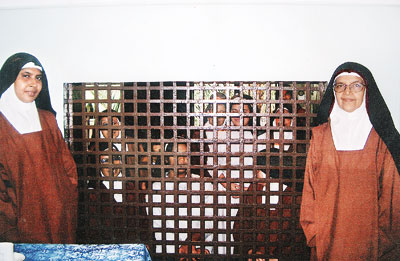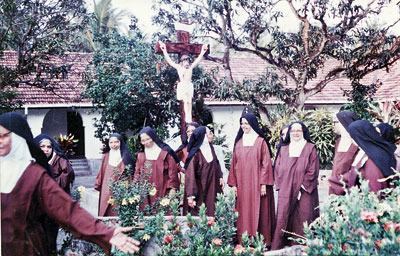Away from the world, for the sake of the world

The ‘Extern’ nuns and beyond the grill the ‘cloistered’ nuns
As men, women and children in Sri Lanka as well as the far corners of the world gather around the lowly crib of Baby Jesus today to celebrate the birth of this ‘humble’ king, by His side are His beloved mother, Mary, and foster father, Joseph.
Iconic is Mary and considered the world’s ‘most powerful woman’. The qualities inherent in the Mother of Christ which are evident when looking deeply at her life, are unquestioning obedience to the will of God and a prayerful existence……..“I am the Lord’s servant,” she told Angel Gabriel, “let everything you have said happen to me.”
And emulating Mary’s prayerful life, taking her as their Patroness and rejoicing over a history-changing event 2,016 years ago, are the ‘Carmelites’ of Sri Lanka.
Nestling amidst the very heart of busy Mattakkuliya (Colombo 15), with the frenetic sounds of trishaws rushing hither and thither and other vehicles going about tooting their horns loudly in the rat race of life wafting over the walls, lies the ‘Corpus Christi Carmel’ Convent on five acres of well-tended gardens, an oasis of serenity and tranquillity.
This is the home of the nuns of the Order of the Discalced Carmelites established in Sri Lanka in 1935, leading a life of prayer, silence and solitude. They are followers of the Lady of Mount Carmel, who is Mother Mary, walking in the footsteps of St. Teresa of Avila, Spain (1515-1582), who showed the way when she said: “Let nothing disturb you, Let nothing frighten you. All things pass away………..God alone suffices.”
The order’s origins lie with the Prophet Elijah who lived on Mount Carmel in the Mediterranean in a prayerful quest for a union with God, which in the 13th century spread to Europe, with St. Teresa adopting this “hermit ideal” and founding this vocation later. ‘Discalced’ means belonging to a strict order of Catholic nuns who are barefoot or in simple sandals.
As such, there is ‘humility’, ‘detachment’ and ‘love for one another’, where Carmelites lead a different way of life – prayer, penance, austere poverty and strict enclosure……cloistered and contemplative, for the church and the world.
Twelve days before Christmas, seated in front of a metal grille with tiny squares beyond which there is a two-flap wooden partition in the ‘parlour’, I hear chairs being pulled up. Suddenly, the partition is opened and before me are four nuns clad in their habits of chocolate brown and black and white veils smiling sweetly through the grille. From beyond, I hear the mooing of cows, the clucking of hens and the crowing of cockerels.
“It is the inner spirit who drew us from the time we were quite young,” smiles one, while another adds, “We like to pray and stay united with the Lord at all times.”
They are not alone in this vocation, though they are the oldest founded by the French Sisters of Cholet 81 years ago. ‘St. Joseph Carmel’ has followed in 1950 in Kandy with 16 nuns and ‘Carmel of Immaculate Heart of Mary’ in 1967 in Galle with 10 nuns. Each convent is a composite whole, following their vocation under the gentle guidance of its own Mother Prioress, bringing to mind the Medieval Ages.
How do they survive in isolation from the bigger world?
Among them are two ‘Extern’ nuns who deal with the outside world and occupy rooms in the ‘public areas’ of the convent, answering the gate-bell and seeing to the needs of those who seek succour here. These are the nuns who let me in.
Once the cloistered nuns pass through the white-painted two-panel door, to their abode, the protocols change. They do not come out, except in exceptional circumstances. “We go out into the world beyond the walls of the convent only if we need medical treatment or to vote,” smiles one, while the others nod their veiled heads vigorously. They never go back home even for a funeral and once in a while their kith and kin will come visiting, but the exchanges take place across the grille. Their very own ‘Family of Sisters’ are within the walls of the convent and even when death comes, they are laid to rest in a cemetery in the same compound.
If there are any requests for prayer and intercession by the public or even alms, they are passed to the Mother Prioress on a ‘Turn’ revolver and when the cloistered nuns need to pass on a message to the ‘Externs’ or vice versa, it is the tinkling of a bell which will alert a response.
The daily routine is simple, differing only on feast days. The rattle or the clapper wakes the nuns from their slumber in their individual Spartan ‘cells’ at the crack of dawn, 4.45 a.m., summoning them to a salutation of Mary, followed by the ‘Morning Prayer’ or ‘Lauds’ which celebrates the resurrection of Christ in the beautiful chapel and the ‘Mental Prayer’ in silence and solitude. Then come the first of three 10-minute ‘Prayers during the Day’ called ‘minor hours’, dedicated to the Holy Spirit, followed with Spiritual Reading.
The highlight of the morning is the Eucharistic Sacrifice celebration at 6.45 a.m., conducted by the priests from the Oblates of Mary Immaculate (OMI) from across the road. Here too the cloistered nuns participate from behind a metal grille, while receiving Holy Communion through a small aperture in the wall close to the grille.
Breakfast at 7.45 a.m. in the refectory is a ‘standing’ sparse meal, a piece of plain bread gulped down with a cup of tea, mimicking the ‘ready to go’ attitude of the Israelites when they left for the Promised Land from Egypt. On feast days, a dab of butter is added to the bread.
From 8 -11 a.m. is ‘Work’, with each attending to her assigned chores such as tending to the sick nuns, arranging the beds, cooking, laundering, sewing, preparing the chapel and keeping their home spic and span, in silence while also sewing the altar linen, making rosaries, looking after the poultry and cows and tending the garden. Thereafter, the ‘Midday Prayer’ is murmured along with the examination of conscience.

In the convent garden, a little time of recreation
An exacting morning of work is followed by lunch, simple fare of rice and curry, in the refectory, eaten in silence, with a nun reading from the Scriptures. Afternoon tea would be at 3.15 once again gulped down standing. Supper being at 7 p.m. their plates would have whatever is left-over from lunch. Each nun has to wash up her plate and cup after every meal, leaving nothing behind on the table.
“Each has a job to do,” says the Mother Prioress, adding that they also try to be self-sustainable by selling milk and eggs. “The Sisters are very talented, we make our own non-alcoholic thambili wine, sew baby clothes, make little booties, do a few handicrafts and sell them.”
At 12.30 p.m. is ‘Recreation’, when there is talk, laughter and joking. It is also the time when the Mother Prioress would glance through the newspapers if something of importance is taking place nationally. The exceptions, of course, are Sundays and feast days when they indulge in music, singing, games or a stroll in the garden.
Then a siesta or ‘Time of Retirement’ in their cells, working, praying or resting till 2 p.m. followed by the ‘Afternoon Prayer’, another of the minor hours.
A bell sharp at 3 p.m., reminds them of the Crucifixion on Calvary, making them prostrate themselves and murmur the Divine Mercy. The solitary ‘Mental Prayer’ next gives way to the afternoon hours being engaged in work such as gardening.
‘Vespers’ (Evening Prayer) follows and after reciting the Angelus, the third time for the day, the Carmelites make their way to the refectory for supper and then recreation, when the Mother Prioress would inform her community about prayer requests and a nun assigned the task of keeping track of e-mails would check whether there are any messages from their Superior General in Rome.
This is followed by the ‘Night Prayer’ around 8.30 p.m. and the recitation of the Rosary together.
From then onwards, stillness descends on the convent once again, no verbal communication taking place unless absolutely essential, with the ‘Devotions in Great Silence’ in their cells and the lights go off one by one at 10 p.m.
Truly a life of sacrifice for humanity, reflecting that of the Baby Boy, over whose birth millions are rejoicing today.
| Celebrating ChristmasChristmas is a special time even for the Carmelites. On the very first Sunday of Advent, the time of expectant waiting and preparation for the celebration of the Nativity, the nuns have dipped their hands into a box with written messages indicating how each one should ‘visit’ the crib – whether on a camel, in a wheelchair, a boat or a car. Smilingly, the nuns relate how innovative they have become, adding a sail to the boat and also oars or making a camel with hardboard. The morning of December 24, the Mother Prioress would tenderly take the statue of the Blessed Mother of Jesus in procession from cell to cell, with two Sisters bearing lit candles, incense filling the air and bells a-ringing. Each Sister would kneel and kiss the Blessed Mother’s feet, while the haunting notes of the Ave Maria reverberate through the convent. The birth of Jesus at midnight on December 24 is preceded by carol-singing and after Mass the Mother Prioress would distribute ‘gifts’ – a bag of toffees, a calendar or a notebook. December 25th being a special day of rejoicing, breakfast would be a leisurely event, not standing but seated and not in the refectory but on the verandah, looking out into the garden. |


